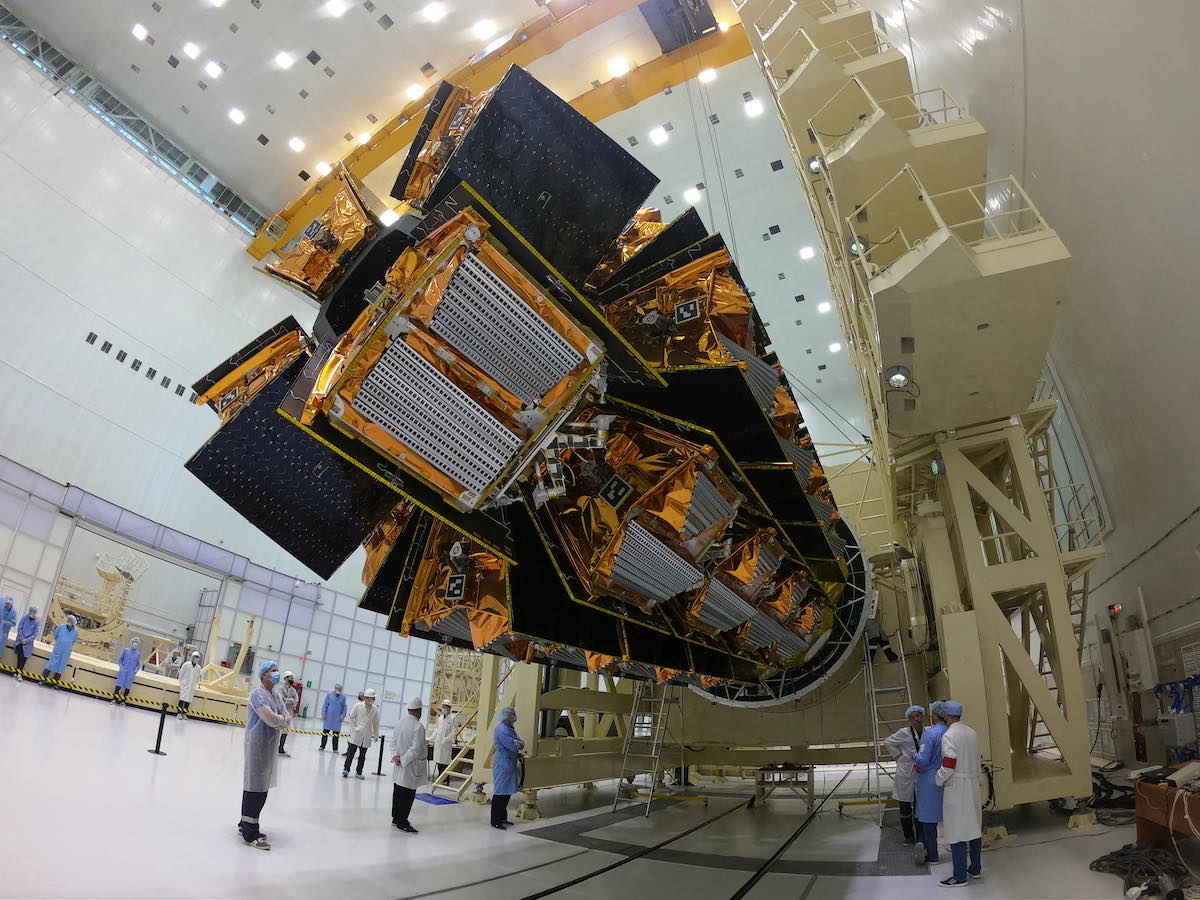
A Russian Soyuz rocket and Fregat upper stage deployed 36 more OneWeb internet satellites into orbit Thursday, bringing the company’s fleet to 254 spacecraft, enough to start commercial service above 50 degrees latitude.
A Soyuz-2.1b rocket fired off a launch pad at the Vostochny Cosmodrome in Russia’s Far East at 8:48:33 a.m. EDT (1248:33 GMT) to begin a nearly four-hour mission delivering the 36 OneWeb satellites to orbit.
Liftoff occurred at 9:48 p.m. local time at Vostochny to begin the third Soyuz launch in six days.
The mission Thursday followed Soyuz rocket flights from the Plesetsk Cosmodrome in Russia on June 25 and a launch of a Progress resupply ship to the International Space Station Tuesday from the Baikonur Cosmodrome in Kazakhstan.
Thursday’s launch took off from Russia’s newest spaceport, Vostochny, on the eighth Soyuz mission dedicated to carrying satellites for OneWeb, a London-based company building out a global space-based internet network.
The launch of 36 more spacecraft brings OneWeb’s constellation to 254 satellites. The company plans to launch 648 satellites through next year to fill out its first-generation fleet providing low-latency internet services.
OneWeb’s satellites were fastened inside the nose cone of the Soyuz-2.1b rocket for launch Thursday. A Fregat upper stage mounted on top of the Soyuz rocket completed the task of placing the OneWeb spacecraft into orbit.
Each OneWeb satellite is about the side of a mini-fridge. The spacecraft are built by OneWeb Satellites, a joint venture between OneWeb and Airbus, in a factory just outside the gate of NASA’s Kennedy Space Center in Florida.
The OneWeb satellites beam broadband internet signals to users on the ground, at sea, or in the air, providing high-speed, low-latency connectivity for consumers, large companies, and governments. OneWeb is competing with SpaceX’s Starlink network, along with planned internet constellations from other companies.
With the satellites launched Thursday, London-based OneWeb will have enough satellites to provide internet services to customers north of 50 degrees latitude. That will take a few months as the new spacecraft go through post-launch testing and orbit-raising.
OneWeb emerged from bankruptcy last year under the ownership of Bharti Global and the UK government, and resumed launches in December.
“This latest launch of OneWeb satellites will put high-speed broadband within reach of the whole Northern Hemisphere later this year, including improving connectivity in the remotest parts of the UK,” said British Prime Minister Boris Johnson.
“Backed by the British government, OneWeb proves what is possible when public and private investment come together, putting the UK at the forefront of the latest technologies, opening up new markets, and ultimately transforming the lives of people around the world,” Johnson said in a statement.
Liftoff of the Soyuz-2.1b rocket from the Vostochny Cosmodrome, boosting the next 36 satellites into orbit to expand the reach of OneWeb’s internet network. https://t.co/VklsHi6EYy pic.twitter.com/0bKroG4un4
— Spaceflight Now (@SpaceflightNow) July 1, 2021
“This is a truly historic moment for OneWeb, the culmination of months of positive momentum in our ‘Five to 50’ program, increased investment from our global partners and the rapid onboarding of new customers,” said Neil Masterson, OneWeb’s CEO. “We are incredibly excited to start delivering high-speed, low-latency connectivity first to the UK and the Arctic region and to see our network scale over the coming months as we continue building to global service.”
OneWeb acquired the Soyuz launch services through Arianespace, the French launch services provider.
Four Soyuz launches for OneWeb are scheduled from the Baikonur Cosmodrome in Kazakhstan later this year — two in August, one in September, and one in December. Each mission will deploy more than 30 OneWeb satellites.
There’s also a Soyuz launch for OneWeb scheduled from the Guiana Space Center in South America later this year.
After taking off from Vostochny Thursday, the Soyuz-1.b rocket shed its four kerosene-fueled first stage boosters about two minutes after liftoff, then the payload shroud jettisoned at T+plus 3 minutes, 35 seconds, once the vehicle climbed above the thick, lower layers of the atmosphere.
The Soyuz core stage fired until just shy of the five-minute mark in the mission, then separated to fall back to the ground over Russian territory.
The rocket soared into sunlight a few minutes after liftoff, which occurred soon after sunset at Vostochny. The sunshine illuminated rocket’s expanding exhaust plume, creating a spectacular light show in a live video broadcast from the launch site.
A third stage engine lit to propel the Fregat upper stage and stack of OneWeb satellites on a ballistic, suborbital trajectory. Then the Fregat main engine ignited at T+plus 10 minutes, 22 seconds, for a five-minute burn to place the OneWeb satellites into a preliminary elongated orbit.

After soaring north over the Arctic Ocean and back south again, a second burn by the Fregat upper stage about 73 minutes after liftoff finished the job of placing the OneWeb payloads into the proper 279-mile-high polar orbit for deployment.
The Fregat upper stage release the OneWeb satellites into orbit four at a time, with pulses by the Fregat’s smaller control thrusters between each deployment to provide spacing between the spacecraft. The final quartet of satellites separated from the Fregat upper stage nearly four hours after liftoff.
OneWeb’s mission control acquired signals from all 36 satellites, confirming their health after arriving in orbit.
The satellites were programmed to extend their power-generating solar panels and switch on xenon-fueled plasma thrusters to being raising their altitude to 745 miles (1,200 kilometers), where they will join the rest of the OneWeb constellation.
Email the author.
Follow Stephen Clark on Twitter: @StephenClark1.
